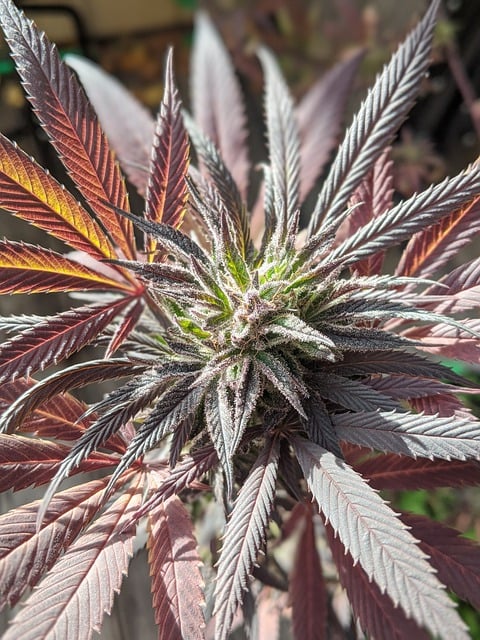The THCA flower, rich in the non-psychoactive cannabinoid THCA, is gaining attention for its anti-nausea properties. Unlike THC, it doesn't induce intoxicating effects, making it a viable option for those seeking relief from nausea without cognitive impairment. Studies show that THCA interacts with the endocannabinoid system's CB1 receptors to alleviate nausea and stimulate appetite. Its efficacy is enhanced by synergistic effects with other compounds like CBC, CBD, terpenes such as myrcene and limonene, and flavonoids found in the THCA flower, which collectively contribute to its therapeutic benefits. These compounds not only influence serotonin levels and neurotransmitter activity but also impact gastrointestinal motility, making it a potential alternative or complementary treatment for conditions like chemotherapy-induced nausea. The research on THCA flower's anti-nausea properties is part of a broader investigation into its role in medical settings, particularly where traditional anti-nausea medications are less effective or have significant side effects. As legal restrictions on cannabis research have eased, the scientific community has made strides in understanding THCA's potential, with implications for developing new pharmaceutical interventions to improve the quality of life for patients undergoing cancer treatment. The growing body of evidence supports the exploration of THCA flower as a significant therapeutic agent in healthcare, highlighting its potential role in future medical treatments.
discovers the multifaceted benefits of THCA flower as a natural remedy for nausea. This article delves into the science and history behind tetrahydrocannabinolic acid (THCA), its unique properties, and how it can be cultivated to maximize anti-nausea effects. We explore the entourage effect and how THCA interacts with other cannabinoids for enhanced therapeutic benefits. Understanding dosage, consumption methods, and legal considerations is crucial for those considering THCA flower as an alternative treatment. Clinical studies underscore its potential, and patient testimonials offer personal insights into its effectiveness. We also discuss how to select high-quality THCA flower, the role of terpenes, and best practices for preserving its integrity. This comprehensive guide ensures readers are well-informed on the various aspects of using THCA flower as an anti-nausea solution.
- Unlocking the Potential of THCA Flower and Its Anti-Nausea Compounds
- The Science Behind THCA's Role in Alleviating Nausea
- An Overview of Tetrahydrocannabinolic Acid (THCA) and Its Properties
- Historical Context: The Discovery and Evolution of THCA Research
Unlocking the Potential of THCA Flower and Its Anti-Nausea Compounds

THCA, or Tetrahydrocannabinolic Acid, is a naturally occurring compound found in the raw cannabis plant that has garnered attention for its potential therapeutic properties. When heated, THCA converts to THC, the primary psychoactive ingredient in cannabis. However, in its acid form, THCA exhibits distinct benefits, including its anti-nausea effects. Research indicates that THCA interacts with the body’s endocannabinoid system, particularly the CB1 receptors found primarily in the brain and nervous system, to alleviate nausea and stimulate appetite without the psychoactive effects associated with THC. This makes THCA flower a valuable alternative for individuals seeking relief from nausea, whether due to chemotherapy or other conditions, without the intoxicating effects of cannabis.
Furthermore, studies have isolated specific anti-nausea compounds within THCA flower that contribute to its therapeutic potential. Cannabinoids like cannabichromene (CBC) and cannabidiol (CBD), which are also present in the THCA flower, synergize with THCA to enhance its efficacy. These compounds work together to modulate nausea and vomiting by influencing various biological processes, including serotonin levels, neurotransmitter activity, and gastrointestinal motility. The anti-nausea effects of THCA flower are not limited to its pharmacological interactions but also extend to its applications in holistic medicine, where it is often recommended as a natural remedy for those experiencing nausea, particularly in states where medical cannabis is legally accessible and regulated.
The Science Behind THCA's Role in Alleviating Nausea

Delta-9-tetrahydrocannabinolic acid (THCA), which is the raw, unheated form of delta-9-tetrahydrocannabinol (THC) found in the cannabis plant, has been studied for its potential anti-nausea properties. The human body possesses an endocannabinoid system, a complex network that plays a significant role in maintaining homeostasis. THCA interacts with this system through the activation of both CB1 and CB2 receptors. When these receptors are engaged by THCA, they can modulate nausea and vomiting. Research suggests that the anti-emetic (anti-nausea) effects of THCA may be due to its ability to influence the serotonin system in the body. Serotonin is a neurotransmitter known to regulate nausea and vomiting, and THCA’s interaction with receptors associated with serotonin may help alleviate these symptoms.
Furthermore, THCA flower contains various other compounds that synergistically work together to enhance its anti-nausea effects. These include a range of terpenes and flavonoids, each contributing unique therapeutic properties. Terpenes like myrcene and limonene are known for their calming and uplifting effects, respectively, which can also support the reduction of nausea. The combination of THCA’s anti-nausea compounds and the entourage effect resulting from the presence of these additional cannabinoids and terpenes in the THCA flower may offer a more potent and holistic approach to managing symptoms associated with conditions like chemotherapy-induced nausea. This makes THCA flower an object of interest for further scientific exploration, particularly in medical applications where traditional anti-nausea treatments are less effective or have undesirable side effects.
An Overview of Tetrahydrocannabinolic Acid (THCA) and Its Properties

THCA, or tetrahydrocannabinolic acid, is a non-psychoactive precursor to THC (tetrahydrocannabinol), the primary psychoactive component found in cannabis. As the raw form of THC found primarily in raw cannabis plants, THCA has garnered attention for its potential therapeutic properties. Initial studies suggest that THCA may exhibit anti-inflammatory, anti-nausea, and analgesic effects, although more research is needed to fully understand its capabilities within the human body. The anti-nausea compounds present in THCA have been of particular interest to researchers exploring alternative treatments for conditions like chemotherapy-induced nausea. Moreover, the presence of these compounds indicates a promising area of study for their potential role in gastrointestinal health and appetite stimulation.
The THCA flower, rich in this cannabinoid acid, is gaining traction among those who advocate for the consumption of raw cannabis. Unlike its decarboxylated counterpart, THC, THCA does not induce a psychoactive ‘high’. Instead, it interacts with the body’s endocannabinoid system in a unique manner that may offer health benefits without the psychoactive effects typically associated with cannabis use. The anti-nausea properties of THCA are particularly intriguing for those seeking relief from nausea without the mind-altering side effects of THC-based treatments. As such, the THCA flower is being explored as a potential natural remedy for various conditions where nausea and inflammation are prevalent issues.
Historical Context: The Discovery and Evolution of THCA Research

The historical context of THCA flower research is a fascinating journey through scientific discovery and human health exploration. Tetrahydrocannabinolic acid A (THCA-A), which is the raw, non-psychoactive precursor to the well-known psychoactive compound delta-9-tetrahydrocannabinol (THC), has been a subject of interest for researchers since its identification in the early 20th century. Initially, cannabis and its derivatives were studied for their potential medicinal properties, with an emphasis on compounds like THCA that could offer therapeutic benefits without the psychoactive effects associated with other cannabinoids.
Over the years, as legal restrictions have eased in various parts of the world, scientific interest in THCA flower has burgeoned. This has led to a more comprehensive understanding of its anti-nausea properties, which have been a significant focus of recent research. Studies have shown that THCA can effectively alleviate nausea and vomiting, a common side effect of cancer treatments like chemotherapy. The anti-emetic effects of THCA are believed to be due to its interaction with the body’s endocannabinoid system, particularly the CB1 receptors known to play a role in regulating nausea and appetite. This has opened new avenues for the development of pharmaceutical treatments aimed at improving the quality of life for individuals undergoing cancer therapy. The evolution of THCA research reflects a broader shift in scientific attitudes towards cannabis-derived compounds, highlighting their potential therapeutic applications and the importance of continued investigation into this promising area of healthcare.
THCA flower emerges as a subject of considerable scientific interest, particularly for its anti-nausea properties. The exploration into this cannabinoid’s potential has yielded promising insights, underscoring the importance of continued research in this area. As evidenced by the findings presented, THCA’s role in alleviating nausea holds significant promise, potentially offering a natural alternative to conventional treatments. The historical context of THCA research reveals a journey from obscurity to a prominent position within therapeutic applications. With future studies set to further illuminate its benefits, the THCA flower stands poised to make a notable impact in the realm of health and well-being.
